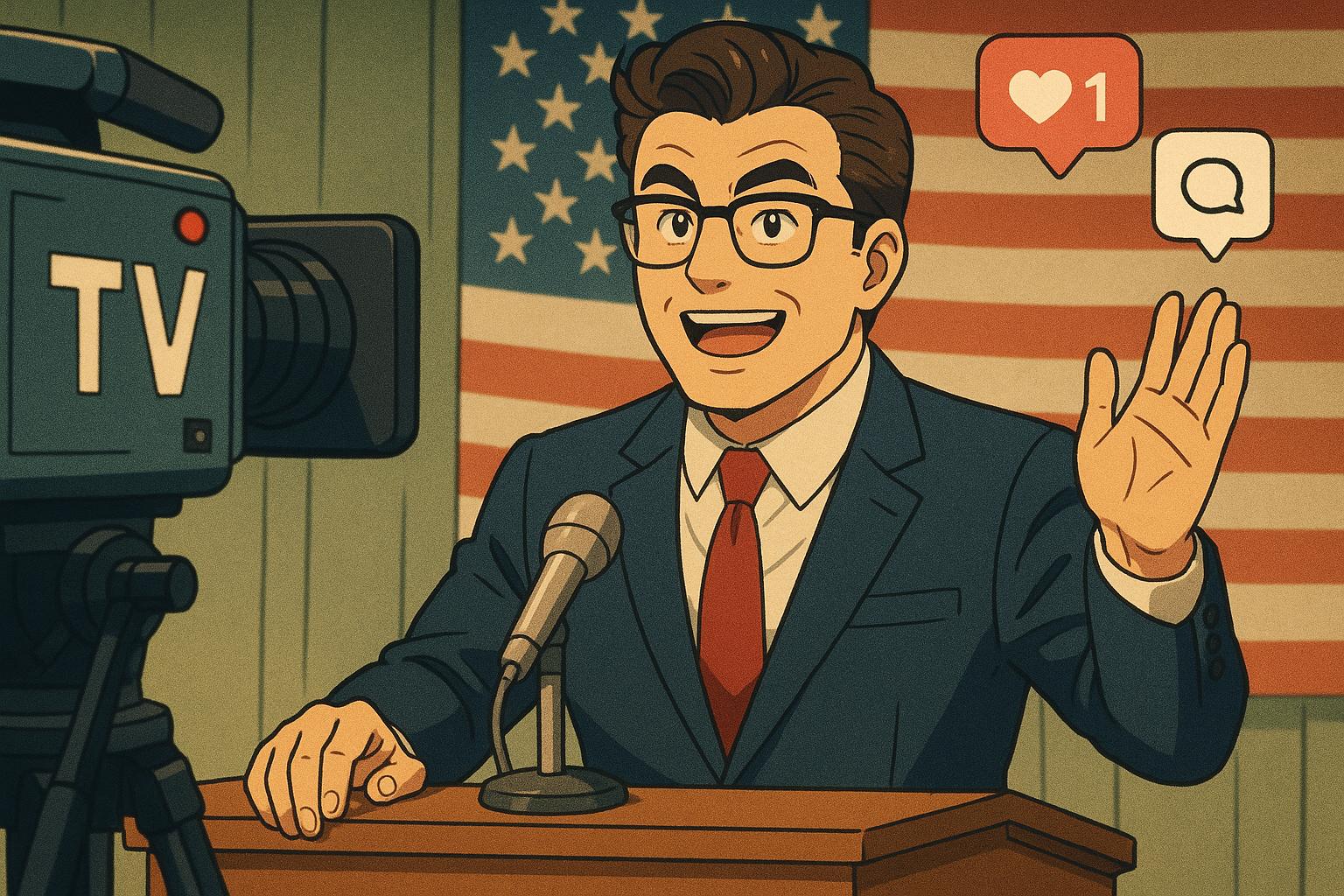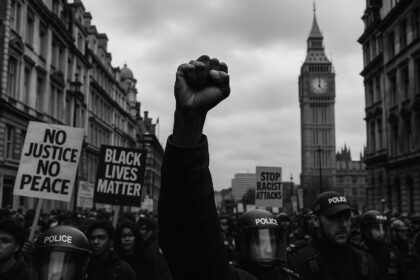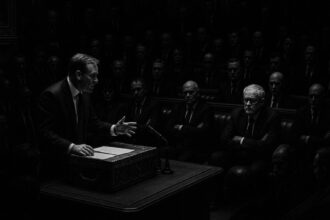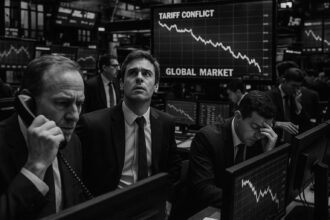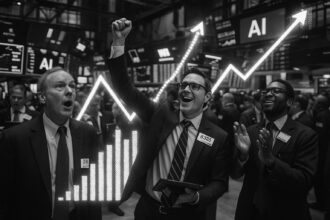From JFK’s televised charisma to Trump and Farage’s unfiltered social media presence, political communication has transformed dramatically, reflecting a cultural demand for candidness that challenges traditional messaging.
In an era where the line between authentic communication and strategic persona is increasingly blurred, the concept of the “TV politician” has evolved significantly. Traditionally, this term evoked images of figures like John F. Kennedy, who masterfully harnessed the power of television to craft a dynamic and engaging public image. Kennedy, influenced by his father’s Hollywood connections, understood that in the television age, image was almost as crucial as policy. His performances during debates—most notably against Richard Nixon in 1960—illustrated the impact of visual presentation on public perception. Voters were less swayed by policy nuances than by Kennedy’s polished confidence and vigour, a phenomenon underscored in his televised addresses during moments of crisis like the Cuban Missile Crisis, where his calm demeanor reinforced American resolve.
In stark contrast, contemporary political figures such as Donald Trump and Nigel Farage exemplify a new breed of politician, adept in a ‘post-TV’ environment shaped by social media and direct communication. Trump, for instance, has skilfully used platforms like Twitter to cultivate an image of authenticity that often deviates from the carefully cultivated personas of his predecessors. His rise was marked less by traditional political acumen and more by his ability to resonate with an audience hungry for unfiltered commentary. As a former reality TV star, Trump repackaged his celebrity into a political persona that seemed genuine—he displayed a so-called “controlled anarchy” that captivated a disillusioned electorate.
This perceived authenticity is further enhanced by the structure of their respective political movements, where both Trump and Farage hold unchallenged leadership roles that allow them to speak freely without fear of internal opposition. This stands in stark contrast to established politicians like UK Prime Minister Keir Starmer, who, while attempting to sound relatable, often delivers tightly scripted messages that come off as banal and detached. The sheer candidness that audiences now expect from politicians stems from the immediacy of social media; such demands render older modes of communication less effective.
Moreover, the shift in political communication dynamics can be observed in how public figures in other realms, such as entertainers and social media influencers, engage with audiences. Musicians frequently share their unvarnished experiences—everything from tour mishaps to personal struggles—making their narratives relatable. This type of communication fosters a sense of intimacy that has now become the gold standard for authenticity in public discourse. In contrast, traditional politicians often fall short, appearing evasive and rehearsed, unable to connect meaningfully with an electorate that craves transparency and authenticity.
The evolution of political communication also reflects a broader cultural shift. Traditional political parties, once pillars of authority comfortably situated in the television age, now flounder in a landscape dominated by smartphones and social media. Their attempts to engage with the public often resort to methods that seem archaic and insincere when juxtaposed with the immediate, personal connections afforded by today’s digital platforms. The gap between the so-called ‘old-school’ political messaging and the new demands of the electorate poses a challenge for longstanding political institutions as they grapple with maintaining relevance in a rapidly changing media environment.
The challenges presented by this new political paradigm are evident; while established politicians strive to adapt, their communication strategies may seem out of touch. As Kennedy demonstrated the power of image in a previous era, Trump and Farage represent a paradigm shift, riding the waves of a more chaotic, yet ultimately candid, form of interaction. The landscape of political communication is one that now requires a greater openness and adaptability than ever before, favouring those willing to embrace their authenticity over those clinging to old formats and conventions.
The evolution of the political narrative, from Kennedy’s polished oratory to today’s snap judgments in the digital age, underscores a pivotal shift in how leaders must now navigate the complex interplay between media, messaging, and public perception, demanding a recalibration of how we understand the term “politician” in the modern context.
Reference Map
- Paragraph 1: [3], [4]
- Paragraph 2: [2]
- Paragraph 3: [2], [6]
- Paragraph 4: [2]
- Paragraph 5: [7]
- Paragraph 6: [1], [6]
- Paragraph 7: [1], [2]
Source: Noah Wire Services
- https://www.ft.com/content/c5a00787-6c67-4eec-a76f-b3e5fedc4826 – Please view link – unable to able to access data
- https://www.ft.com/content/c5a00787-6c67-4eec-a76f-b3e5fedc4826 – This article discusses how Donald Trump and Nigel Farage exemplify a new kind of political figure suited for the ‘post-TV’ era. Unlike traditional ‘TV politicians’ such as JFK, Harold Wilson, or David Cameron—who curated carefully crafted personas for television audiences—Trump and Farage present an image of authenticity by breaking from the scripted norms of political communication. They capitalize on a media environment shaped by social platforms, where candidness and spontaneity are valued. Trump’s past success as a TV persona on The Apprentice helped craft an illusion of business acumen, but his real power lies in his ability to appear unrehearsed and unfiltered. Farage, similarly, thrives in this new landscape by presenting himself as blunt and genuine. Their perceived authenticity is further enabled by their dominance within their own political movements, which allows them to speak freely without internal opposition. In contrast, traditional politicians, tethered to outdated communication strategies designed for television, struggle to resonate in a smartphone-driven world that demands greater openness and immediacy.
- https://time.com/4795637/jfk-television/ – This article explores how John F. Kennedy revolutionized the use of television in politics, recognizing the critical importance of image in the television age. Influenced by his father, Joseph P. Kennedy, a former film mogul, and through personal experiences, JFK honed his on-screen persona, understanding its political impact. He articulated his belief in the power of television in a 1959 TV Guide article, underscoring the significance of qualities like honesty and vigor in a candidate’s image. His adept use of television shone through during his 1956 Democratic Convention speech and the 1960 Presidential Campaign, marked by his successful debates with Richard Nixon. As president, Kennedy continued to leverage television, holding the first live press conference and collaborating with industry professionals to refine his televised appearances. His administration’s interactions with media demonstrated his unique ability to maintain a dignified and statesmanlike image, reinforcing American ideals.
- https://www.pbs.org/wgbh/americanexperience/features/jfk-presidential-politics/ – This article examines the impact of television on John F. Kennedy’s presidential campaign and administration. It highlights the 1960 presidential debate between Kennedy and Richard Nixon, noting that television allowed viewers to see a contrast between the candidates’ appearances and poise, which influenced public perception. The article also discusses how Kennedy used television to present a carefully constructed public image, showcasing his vigor and confidence. Additionally, it covers how television played a role during critical moments, such as the Cuban Missile Crisis, where Kennedy’s televised address demonstrated resolve and competence. The piece underscores the power of television in shaping political narratives and public opinion during Kennedy’s era.
- https://www.jfklibrary.org/about-us/social-media-podcasts-and-apps/jfk35-podcast/influencing-the-election/transcript – This transcript from the JFK Library podcast discusses the influence of radio and television on political campaigns. It highlights how these mediums allowed candidates to communicate directly with the public in an intimate setting, changing the nature of political messaging. The conversation touches on the challenges campaigns faced in crafting messages that appealed to a broad audience and the necessity for concise communication due to the constraints of broadcast media. The discussion provides insights into how media transformed political campaigning and voter engagement during JFK’s time.
- https://www.washingtonpost.com/lifestyle/magazine/masters-of-their-medium-jfk-on-tv-trump-on-twitter/2021/01/08/eb765bc8-51db-11eb-bda4-615aaefd0555_story.html – This article compares the media strategies of John F. Kennedy and Donald Trump, highlighting how both leaders mastered their respective mediums to communicate directly with the public. It discusses Kennedy’s use of television to enhance his image and connect with voters, noting his understanding of the medium’s power in shaping public perception. The piece also examines Trump’s use of Twitter to bypass traditional media and speak directly to his audience, emphasizing his ability to control his narrative and engage with supporters. The article underscores the evolving role of media in political communication and how leaders adapt to new platforms to influence public opinion.
- https://constitutioncenter.org/blog/jfks-warnings-about-television-money-and-politics-ring-true-today – This blog post reflects on John F. Kennedy’s 1959 essay in TV Guide, where he discussed the influence of television on politics and the potential for manipulation through media. Kennedy warned about the dangers of television being used for ‘manipulation, exploitation and gimmicks’ and emphasized the need for voters to be discerning. The article draws parallels between Kennedy’s concerns and contemporary issues in political communication, highlighting the ongoing relevance of his insights into the relationship between media, money, and politics.
Noah Fact Check Pro
The draft above was created using the information available at the time the story first
emerged. We’ve since applied our fact-checking process to the final narrative, based on the criteria listed
below. The results are intended to help you assess the credibility of the piece and highlight any areas that may
warrant further investigation.
Freshness check
Score:
8
Notes:
The narrative references contemporary figures like Trump and Farage, indicating a recent context. However, the themes discussed are not new and have been explored in previous analyses of political communication.
Quotes check
Score:
5
Notes:
There are no direct quotes in the text to verify against original sources. The narrative relies on general descriptions and comparisons rather than specific statements.
Source reliability
Score:
9
Notes:
The narrative originates from the Financial Times, a reputable and well-established publication, which generally supports the reliability of the information.
Plausability check
Score:
8
Notes:
The claims about shifts in political communication are plausible and align with broader trends observed in media and political science research. However, some assertions could benefit from more specific evidence.
Overall assessment
Verdict (FAIL, OPEN, PASS): PASS
Confidence (LOW, MEDIUM, HIGH): HIGH
Summary:
The narrative discusses plausible shifts in political communication, supported by a reliable source. While lacking specific quotes to verify, the overall thesis aligns well with current media trends.


